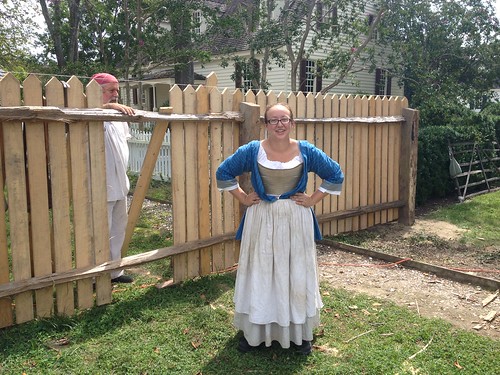Just Do It: Reflections from Libby Cook. In this latest guest blog, Libby reflects on the powerful influences archaeology, material culture, and other fields and trades have on her study of history.
Earlier this week, I participated in a reading group with the author of the book in attendance. That night’s reading selection dealt with the construction of race and identity through the use of material culture, particularly clothing. The author’s advice to the students in the group regarding the use of material culture: “Just go out and do it.”
As a scholar of material culture, this got me thinking. What holds academic historians back from using objects in their analysis? If reading sources “against the grain” has become common practice, why not read sources that have literal grain? What is the benefit of going out and doing it?
I can only speak to the benefits I have seen from actively learning about and engaging with objects. Archaeology taught me to be sensitive to subtle changes in the environment around me. Sometimes that means looking for changes in soil color. Sometimes it means identifying shifting patterns in how people wrote about the buildings in which they lived. Learning eighteenth-century carpentry exposed me to some of the physical realities of that trade as it was practiced. Bad backs, creaking joints, and the occasional need for stitches pair with the knowledge of how to work with the grain in wood, how to cut and fit joints, and how to read the bones of a structure.
 Libby works as a carpentry apprentice in Colonial Williamsburg.
Libby works as a carpentry apprentice in Colonial Williamsburg.
This knowledge is something that I doubt will ever make a blatant appearance in my scholarship. However, it does give me a deeper understanding of my source material (both objects and documents) and that does change the questions I ask, how I read the sources, and the interpretive leaps I am willing to make. The hands-on, practical, physical skills I’ve learned have radically reshaped my research.
Stepping outside the archives and learning skills that require using both one’s head and one’s hands also challenges scholars in unanticipated ways: it introduces them to new communities. Often, in academia, this means finding other academics with whom one shares particular research interests. These communities exist everywhere, though. They are in museums, in libraries, in trades shops, in workshops, in fields. There are individuals and groups who possess living knowledge; knowledge that has never been written down and yet is invaluable to understanding the past. Only by going out and doing, by breaking the traditional bounds of “the academic” or of “history” or of any other categorization you like, can we find these communities.
Just going out and doing brings academics into contact with archaeologists, anthropologists, curators, carpenters, masons, archivists, public historians, indigenous peoples, and an entire world of people and objects that offer different insights into the past. It opens scholars to new ways of seeing and of understanding the world. If nothing else, it gets them out of the ivory tower and forces them to think about how their projects relate both to the lived experience of the past and to present conditions.
Just going out and doing does entail risk. Doors might not be opened. Information might be misunderstood. By staying in, though, we miss all the elements of life that never were written down: the stories, the trade knowledge, the moments when things worked and when things failed, the lives and events inscribed on objects. When we step away from the safety of documents, we find whole worlds formerly locked up beyond our imaginings – and that is worth the risk of going out and doing it.


You don’t hear about “armchair historians” because it’s pretty much redundant, but we can be so self-limiting and conservative in our choice of sources and inspiration. I LOVE this! :):):)